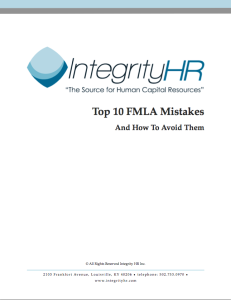It’s just four letters, but it can cause a lot of stress in an organization if not administered properly. It can be your best friend or your worst nightmare.
FMLA.
The Family and Medical Leave Act (FMLA) is a federal law passed in 1993 and revised in 2009. It requires covered employers to:
- Provide unpaid leave for certain family and medical circumstances.
- Reinstate the employee to the same or an equivalent position upon conclusion of an approved FMLA leave.
- Continue health benefits at the same level as prior to the start FMLA leave.
Understanding FMLA requirements is an imperative aspect of running a compliant organization. And we all want to be compliant, don’t we?
If employers do not properly administer requests, they run the risk of becoming liable for misappropriation of benefits.
Although this area can become confusing, today we are going to highlight the top 10 FMLA mistakes business professionals make, as well as how to avoid doing so.
FMLA Mistake #1: Inappropriately determining eligibility
Is your company covered by FMLA? Are your employees eligible for FMLA? You need to figure out the answers to those two questions first and foremost.
Covered employers include companies with 50* or more employees within 75-mile radius of a worksite.
*50 or more employees in 20 or more workweeks in the current or preceding calendar year.
An eligible employee is an employee of a covered employer who:
- Has been employed by the employer for at least 12 months and,
- Has worked for at least 1,250 hours during the 12-month period immediately preceding the commencement of the leave, and,
- Is employed at a worksite where 50 or more employees are employed by the employer within 75 miles of that worksite.
- Has not used all available FMLA leave within the designated 12-month period identified by the employer.
How To Avoid This FMLA Mistake:
Make sure you follow all the criteria above! And here are some more important tips:
The 12 months of employment do not need to be consecutive. Separate periods of employment will be counted, provided that the break in service does not exceed seven years.
Separate periods of employment will be counted if the break in service exceeds seven years due to covered National Guard or military service obligations or when there is a written agreement stating the company’s intention to rehire the employee after the service break.
And what about couples?
When a husband and wife both work for the company
- and each wishes to take leave for the birth of a child, adoption or placement of a child for foster care, or to care for a parent (but not parent-in-law) with a serious health condition, the husband and wife may only take a combined total of 12 weeks of leave.
- and each wishes to take leave to care for a covered ill or injured service member, the husband and wife may only take a combined total of 26 weeks of leave.
 FMLA Mistake #2: Waiting For An Employee To Specifically Ask for FMLA
FMLA Mistake #2: Waiting For An Employee To Specifically Ask for FMLA
When an employee needs time off, they often times don’t know to ask for FMLA by name. As the employer, you need to inform the employee of their options.
How To Avoid This FMLA Mistake:
When your employee needs time off that could be FMLA leave, provide your employee with the notice of eligibility and rights & responsibilities (more about that in the next point).
If you don’t provide the designation notice, time off cannot be counted toward the employees 12 weeks of FMLA. So be sure to follow the steps below.
FMLA Mistake #3: Forgetting To Provide Required Notices
When an employee asks for FMLA, you are required to explain to them eligibility requirements as well as their rights and responsibilities. This is most easily accomplished by providing the employee with the Department of Labor Form WH-381.
After you receive a completed certification, then you are required to provide your designation. This tells the employee if the time has been approved or not. The easiest way to do this is to use the Department of Labor FORM WH-382.
Now you might be wondering how long do you need to keep all of these notices and records?
3-year retention required and records must be separate from personnel files!
What to keep:
- A copy of employer notices to the employee
- Proof of premium payments for employee benefits
- Documentation regarding FMLA disputes, if applicable
- All certifications, re-certifications and medical records.
- All written employee notices to employer of need for leave and FMLA qualifying reasons
 FMLA Mistake #4: Being Inconsistent When Determining “12 Month Period”
FMLA Mistake #4: Being Inconsistent When Determining “12 Month Period”
An employer is permitted to choose one of the following methods for determining the “12-month period” in which the 12 weeks of leave entitlement occurs:
- The calendar year.
- Any fixed 12-month leave year, such as a fiscal year.
- The 12-month period measured forward from the date any employee’s first FMLA leave begins.
- A rolling 12-month period measured backward from the date an employee uses any FMLA leave.
The rolling backward method prevents employees from stacking leave, whereas the calendar method does not prevent this.
The calendar method allows for an employee to use 12 weeks of leave at the end of 1 calendar year and then take 12 weeks of leave at the beginning of the new calendar year.
The measured forward method is ALWAYS used for leaves to care for injured service members.
 FMLA Mistake #5: Inappropriately Calculating Leave Entitlement
FMLA Mistake #5: Inappropriately Calculating Leave Entitlement
FMLA can be used for the following circumstances
- Birth of a child and to care for the newborn child.
- Placement with the employee of a child for adoption or foster care.
- Care for the employee’s spouse, son, daughter or parent with a serious health condition.
- A serious health condition that makes the employee unable to perform the functions of his/her job.
- A qualifying exigency leave for families of members of the National Guard and Reserves when the covered military member is on active duty or called to active duty in support of a contingency operation. This leave may commence as soon as the individual receives the call-up notice. A qualifying exigency must be one of the following:
- Short-notice deployment.
- Military events and activities.
- Child care and school activities.
- Financial and legal arrangements.
- Counseling.
- Rest and recuperation.
- Post-deployment activities.
- Additional activities that arise out of active duty, provided that the company and the employee agree, including agreement on timing and duration of the leave.
- To provide care for a spouse, son, daughter, parent or next-of-kin covered service member with a serious illness or injury incurred in the line of duty on active duty.
- FMLA provides for up to 26 weeks of leave in a single 12-month period for this circumstance.

FMLA leave may be taken intermittently or on a reduced leave schedule with the following exception:
- When leave is taken after the birth or placement of a child for adoption or foster care, an employee may take leave intermittently or on a reduced leave schedule only if the employer agrees.
Whew! Are you tired of reading already? No worries, you can download the complete Top 10 FMLA Mistakes and How To Avoid Them in our nifty whitepaper below.


 FMLA Mistake #2: Waiting For An Employee To Specifically Ask for FMLA
FMLA Mistake #2: Waiting For An Employee To Specifically Ask for FMLA FMLA Mistake #4: Being Inconsistent When Determining “12 Month Period”
FMLA Mistake #4: Being Inconsistent When Determining “12 Month Period”









